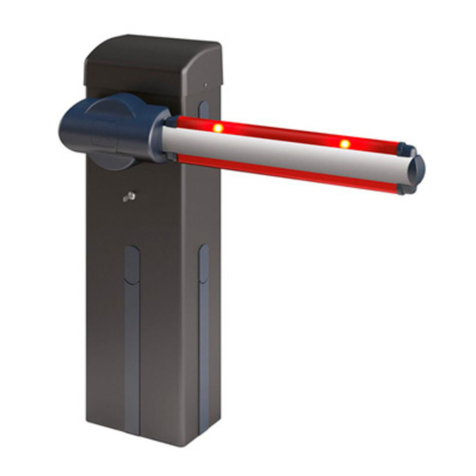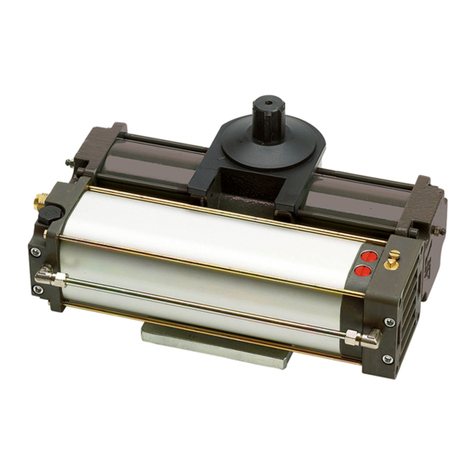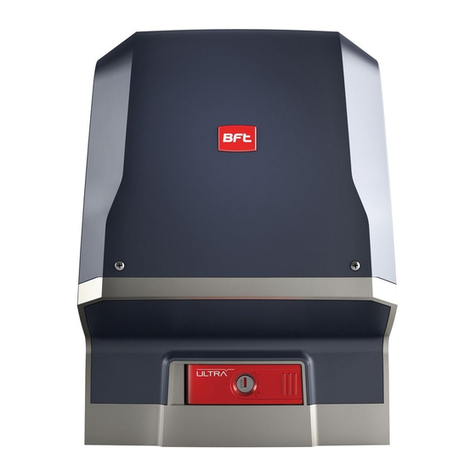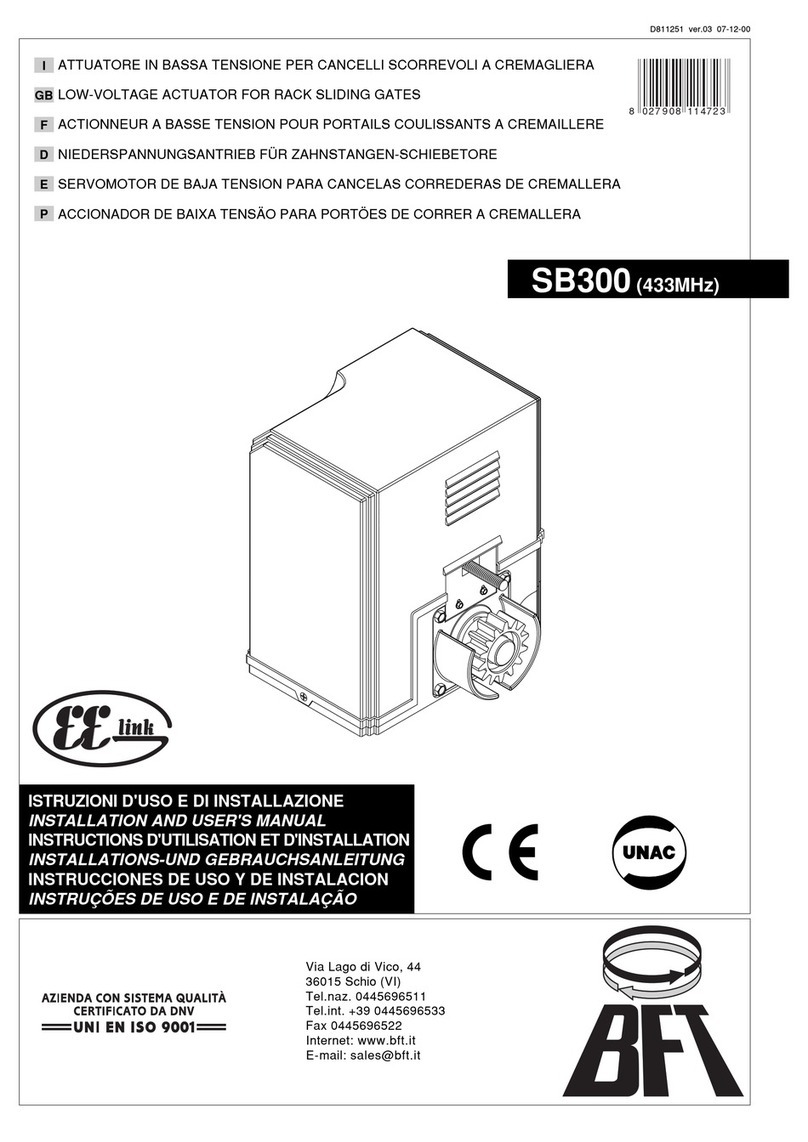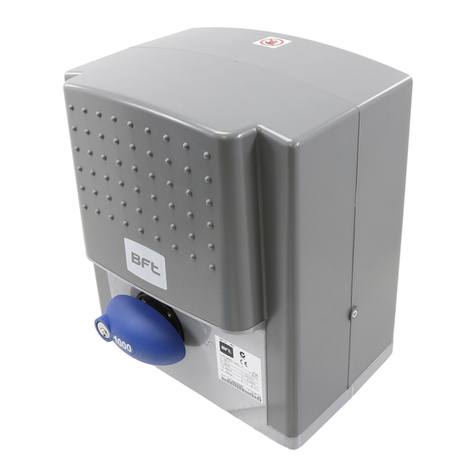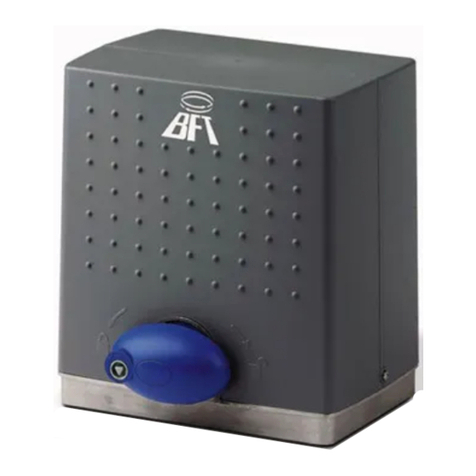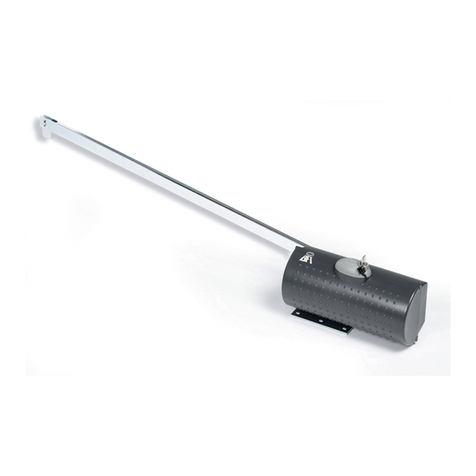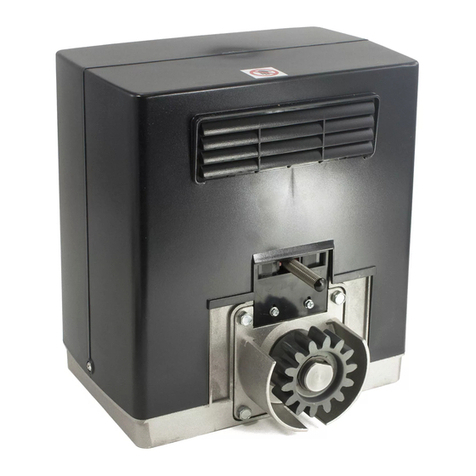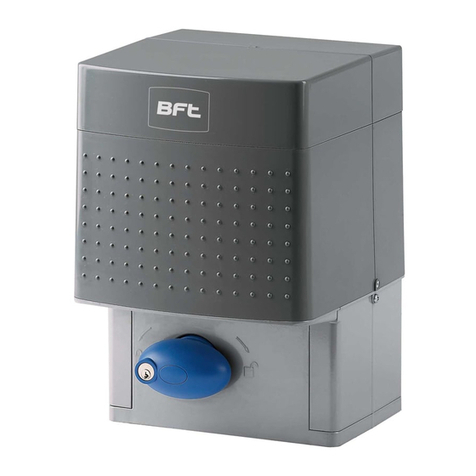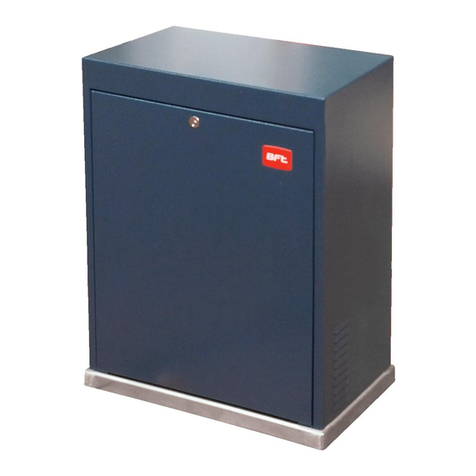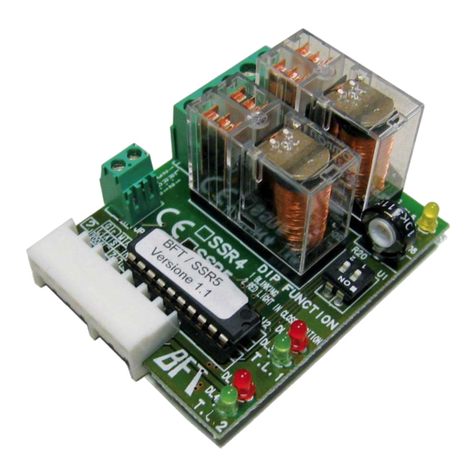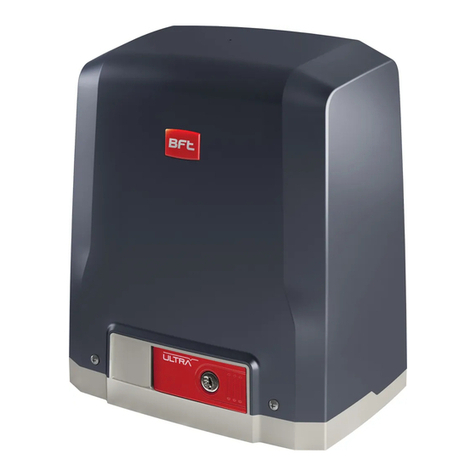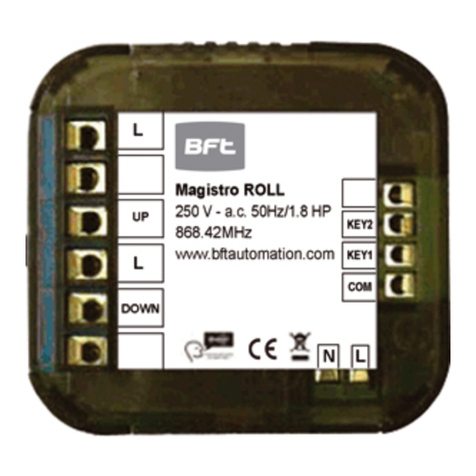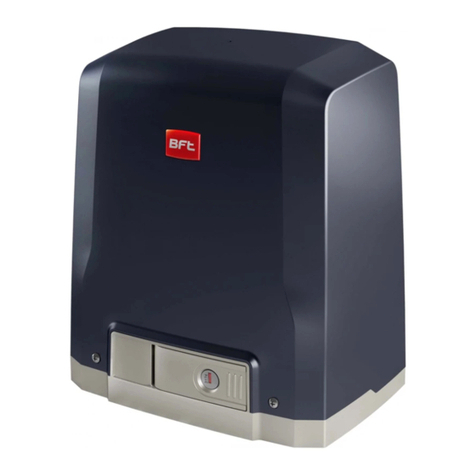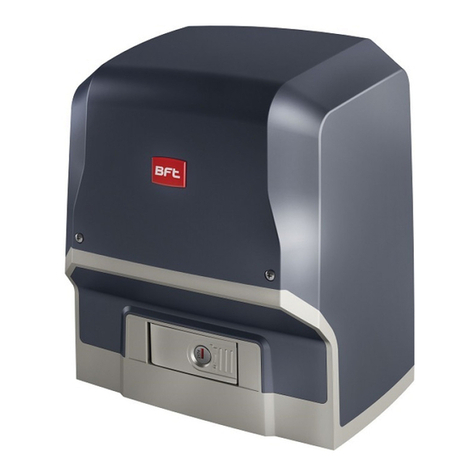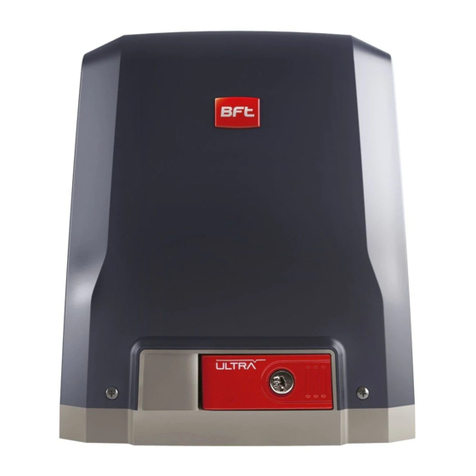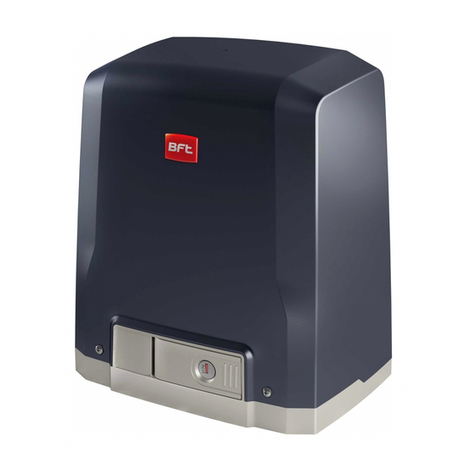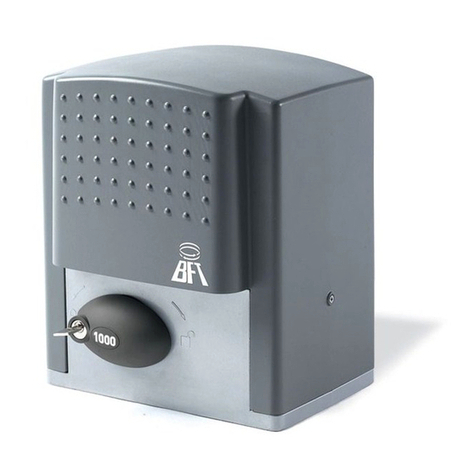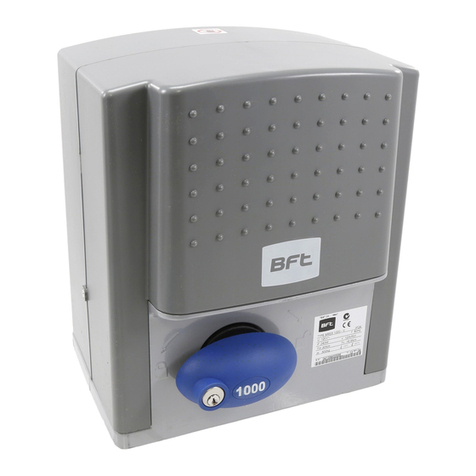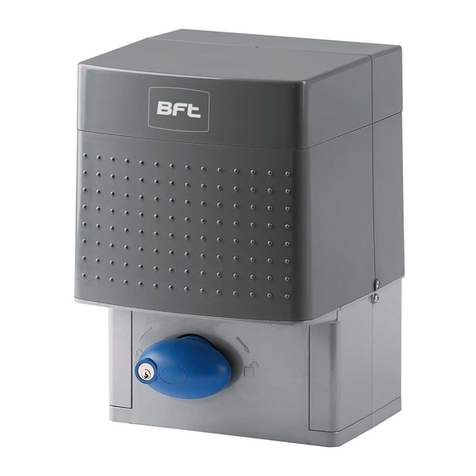
Thank you for buying this product. Our Company is sure that you will be
more than satised with the performance of the product. This product is
supplied with a “WARNINGS” leaet and an “INSTRUCTION MANUAL”.
These should both be read carefully as they provide important informa-
tion about safety, installation, operation and maintenance. This product
complies with recognised technical standards and safety regulations. We
declarethatthisproductisinconformitywiththefollowingEuropeanDirec-
tives:89/336/CEE, 73/23/EEC,98/37/EECand subsequent amendments.
1) GENERAL OUTLINE
Compact electromechanical barrier suitable for limiting private areas,
parkings, access areas for vehicles only. Available for passageways
from 3 to 6 metres. Adjustable electromechanical limit devices ensuring
a correct stop position for the boom. In case of intensive use, a thermal
sensor activates the cooling fan.
The emergency release device for manual manoeuvre is controlled by a
personalised key lock.
The actuator is always supplied for left-hand side tting. However, when
necessary, the opening direction can be reversed by means of simple
operations.
The CBO mod. foundation base (on request) makes barrier installation
easier.
Appropriate ttings make it easy to install accessories without needing
to drill any holes.
TheLEO-MV-D control panelis supplied bythe manufacturer with standard
setting. Any alteration must be set by means of the incorporated display
programmer or by means of Universal palmtop programmer. The Control
unit completely supports the EELINK protocol, including the programmer
self-supply from the control unit.
Its main characteristics are:
- Closing / opening limit-switch inputs
- Separate inputs for safety devices
- Clock input
- Serial protocol connection input
- Incorporated radio receiver
The board is provided with a terminal board which can be pulled out for
easier maintenance or replacement. The board is supplied with a series
of pre-wired jumpers to facilitate the installer’s work.
Thejumpers relate to thefollowingterminals: 21-23, 21-24 and 21-30.If the
above-mentioned terminals are in use, remove their respective jumpers.
2) GENERAL SAFETY
WARNING! An incorrect installation or improper use of the product
can cause damage to persons, animals or things.
• The “Warnings” leaet and “Instruction booklet” supplied with this
product should be read carefully as they provide important information
about safety, installation, use and maintenance.
• Scrap packing materials (plastic, cardboard, polystyrene etc) according
tothe provisionsset out bycurrentstandards. Keepnylon or polystyrene
bags out of children’s reach.
• Keep the instructions together with the technical brochure for future
reference.
• This product was exclusively designed and manufactured for the use
specied in the present documentation. Any other use not specied
in this documentation could damage the product and be dangerous.
• The Company declines all responsibility for any consequences resulting
from improper use of the product, or use which is different from that
expected and specied in the present documentation.
• Do not install the product in explosive atmosphere.
• The construction components of this product must comply with the
following European Directives: 89/336/CEE, 73/23/EEC, 98/37/EEC
andsubsequent amendments. Asfor all non-EEC countries,the above-
mentioned standards as well as the current national standards should
be respected in order to achieve a good safety level.
• The Company declines all responsibility for any consequences result-
ing from failure to observe Good Technical Practice when constructing
closing structures (door, gates etc.), as well as from any deformation
which might occur during use.
• The installation must comply with the provisions set out by the follow-
ing European Directives: 89/336/CEE, 73/23/EEC, 98/37/EEC and
subsequent amendments.
• Disconnect the electrical power supply before carrying out any work
on the installation. Also disconnect any buffer batteries, if tted.
• Fit an omnipolar or magnetothermal switch on the mains power supply,
having a contact opening distance equal to or greater than 3,5 mm.
• Check that a differential switch with a 0.03A threshold is tted just
before the power supply mains.
• Check that earthing is carried out correctly: connect all metal parts for
closure (doors, gates etc.) and all system components provided with
an earth terminal.
• Fit all the safety devices (photocells, electric edges etc.) which are
needed to protect the area from any danger caused by squashing,
conveying and shearing, according to and in compliance with the ap-
plicable directives and technical standards.
• Position at least one luminous signal indication device (blinker) where
it can be easily seen, and x a Warning sign to the structure.
• The Company declines all responsibility with respect to the automation
safety and correct operation when other manufacturers’ components
are used.
• Only use original parts for any maintenance or repair operation.
• Do not modify the automation components, unless explicitly authorised
by the company.
• Instruct the product user about the control systems provided and the
manual opening operation in case of emergency.
• Do not allow persons or children to remain in the automation operation
area.
• Keep radio control or other control devices out of children’s reach, in
order to avoid unintentional automation activation.
• The user must avoid any attempt to carry out work or repair on the
automation system, and always request the assistance of qualied
personnel.
• Anything which is not expressly provided for in the present instructions,
is not allowed.
• Installation must be carried out using the safety devices and controls
prescribed by the EN 12978 Standard.
3) TECHNICAL SPECIFICATIONS
MOOVI 30S
Power supply:..........................................................220-230V 50/60Hz(*)
Absorbed power: ............................................................................300W
Motor: .........................................................................2800 min-1 2 poles
Capacitor: ..........................25µF 450V (220-230V): 100µF 250V (110V)
Absorption: .......................................................................... 0.8 A - 1.6 A
Insulation class:.....................................................................................F
Ventilation intervention temperature:.............................110 °C (winding)
Circuit-breaking intervention temperature: ........... 130 °C (self-resetting)
Reduction gear lubrication:.........................................Permanent grease
Max torque:.....................................................................................72Nm
Minimum opening time: .................................................................. 1.5 s
Boom (aluminium) length:.......................................................... 3m max.
Impact reaction:............................. Obstacle detection device (Encoder)
Limit devices:.................................Electric, incorporated and adjustable
Manual manoeuvre:.....................................................Quick key release
Type of use:...................................................................... semi intensive
Working temperature:.....................................................-10°C to +55 C°
Degree of protection:........................................................................IP24
Operator weight (without boom): ................................... 356N (~35.6 kg)
Dimensions:..............................................................................See g. 1
(*) Special supply voltages available on request.
MOOVI 30 RMM - MOOVI 60 RMM
Power supply:............................................................. 220-230V 50/60Hz
Absorbed power: ............................................................................300W
Motor: ........................................................................1400 min-1, 4 poles
Capacitor: ...............................8µF 450V (220-230V):32µF 250V (110V)
Absorption: ............................................................................ 0.8 A:1.6 A
Insulation class:.....................................................................................F
Ventilation intervention temperature:..............................110°C (winding)
Circuit-breaker intervention temperature:.............. 130°C (self-resetting)
Reduction gear lubrication:.........................................Permanent grease
Max torque:...................................MOOVI-30 85Nm: MOOVI-60 250Nm
Opening time: ........................................... MOOVI-30 4s : MOOVI-60 8s
(Aluminium) bar length: ..................................MOOVI-30 3m max: MOOVI-60 6m max
Max Impact reaction:...................... Obstacle detection device (Encoder)
Limiting devices:............................Electric, incorporated and adjustable
Manual manoeuvre:.....................................................Quick key release
Working temperature:.......................................................-10°C ÷ +55°C
Degree of protection:........................................................................IP24
Actuator weight (without bar):........................................ 356N (~35.6 kg)
Dimensions:...............................................................................See g.1
(*) Special power voltages available on request.
4) FOUNDATION PLATE (Fig.2)
- Prepare a foundation hole suitable for the particular kind of ground.
- Layout several raceways for the electric cables to pass through.
- Position the screws supplied with the CBO mod. base into the 4 xing
holes with the thread facing upwards. Weld the 4 screw heads to the
base and protect the welds with rust preventer. Position the base so
INSTALLATION MANUAL
ENGLISH
16 - MOOVI 30S-30RMM-60RMM Ver. 01
All manuals and user guides at all-guides.com
